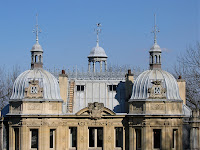 Alexander Dumas not only swept his public off its feet with his swirling adventures of The Three Musketeers and the dark intrigues of The Count of Monte-Cristo, he also dazzled his contemporaries with the construction of an opulent château and park that would be, for a moment, his heaven on earth. Built on a hill between Versailles and Saint-Germain-en-Laye, the opulent château is a testament to the literary lion's legendary extravagance.
Alexander Dumas not only swept his public off its feet with his swirling adventures of The Three Musketeers and the dark intrigues of The Count of Monte-Cristo, he also dazzled his contemporaries with the construction of an opulent château and park that would be, for a moment, his heaven on earth. Built on a hill between Versailles and Saint-Germain-en-Laye, the opulent château is a testament to the literary lion's legendary extravagance.
 It was here in this elegant talk-of-the-town château that Dumas lavishly received a steady stream of guests, opening his doors to any and all.
It was here in this elegant talk-of-the-town château that Dumas lavishly received a steady stream of guests, opening his doors to any and all. A gem of neo-Renaissance architecture, the small château is flanked by two turrets with cupulas each bearing a graceful "AD" monogram. Dumas selected himself the motifs that adorn the façades: angels, flowers, musical instruments, griffons and arms.
Portraits of great writers sculpted in medallions decorate the window pediments; effigies of Virgil, Shakespeare, Dante, Homer, Chateaubriand, Sophocles, Cervantes, Lope de Vega, Racine, Byron, Goethe, Victor Hugo, Corneille and Molière form Dumas' personal panthéon.
When journalist and novelist Léon Gozlan noticed that Dumas' own portrait was not among them he asked, "And you, my good friend, you're not there?"

"Me, I'll be inside," he replied. Later Dumas did place his own effigy above the front entrance so that his face, carved in stone, would smile down at those on his doorstep.
 Because his father was the natural son of a black slave and a French aristocrat, Dumas had the coat of arms of the Davy de la Paillèterie family sculpted on the lintel, to which he added his own motto, "J'aime qui m'aime." (I love who loves me.)
Because his father was the natural son of a black slave and a French aristocrat, Dumas had the coat of arms of the Davy de la Paillèterie family sculpted on the lintel, to which he added his own motto, "J'aime qui m'aime." (I love who loves me.) The entire domain reflects the romantic ideal of the era, from the garden of winding alleys, cascades and hidden caves up to the rooftop where the weather vanes bear the poetic inscriptions: "Au vent la flamme!" (To the wind the flame!) and "Au Seigneur l'ame! (To the Lord the soul!)
The entire domain reflects the romantic ideal of the era, from the garden of winding alleys, cascades and hidden caves up to the rooftop where the weather vanes bear the poetic inscriptions: "Au vent la flamme!" (To the wind the flame!) and "Au Seigneur l'ame! (To the Lord the soul!)
 If it were locals who christened the domain the "Château de Monte-Cristo," it was Dumas who named a second smaller building on the property the "Château d'If" after the sinister prison in The Count of Monte-Cristo. Other than its name, it has nothing in common with the hell-hole where Edmond Dantès languished for fourteen years.
If it were locals who christened the domain the "Château de Monte-Cristo," it was Dumas who named a second smaller building on the property the "Château d'If" after the sinister prison in The Count of Monte-Cristo. Other than its name, it has nothing in common with the hell-hole where Edmond Dantès languished for fourteen years. A masterpiece of picturesque architecture, the tiny two story pavilion with only one room on each floor, sits on a small moated island. This is troubadour style at its best, a liberal and eclectic interpretation of Gothic architecture that was fashionable at the time.


The Château d'If is a blend of diverse architectural elements: Gothic ogives, rosaces and moldings, Swiss-chalet style decorative wood banding, and rustic Normandy half-timbering.
It's façades read like a Dumas bibliography--titles of 88 of his works are engraved in stones interspersed with bas-reliefs of characters from his works.
A foot-bridge that crosses the shallow moat and a stone sculpture of a dog in a doghouse with the latin inscription "cave canem" (beware of dog) heighten the minature bastion's resemblance to a stage decor.

Dumas, seeking a quiet place to work, set up his writing table here, away from the crowd of friends and strangers taking advantage of his hospitality in his main house. The days of heaven on earth are never long. By 1847 Dumas was deeply in debt; unbridled spending and living like a nabob took their toll. In 1848 he was forced to sell his furniture; in 1849 his entire domain was sold at auction for one-seventh of its cost.
In 1969 the château, in an extreme state of disrepair, was rescued from demolition when three surrounding towns leagued together to purchase and restore the domain. After thirty years of hard work by dedicated modern-day musketeers, Monte-Cristo was given back its original sparkle.
Classified as an historic monument and open to visitors: www.chateau-monte-cristo.com
To read more about Château de Monte-Cristo and the Alexandre Dumas' tumultuous life, subscribe to and see my article published at www.literarytraveler.com
Text & Photos ©2010 P.B.Lecron
Click on individual photos to enlarge them.

No comments:
Post a Comment